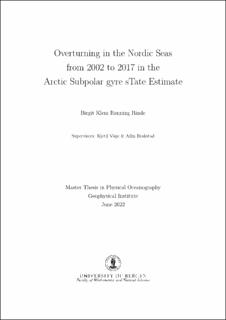Overturning in the Nordic Seas from 2002 to 2017 in the Arctic Subpolar gyre sTate Estimate
Master thesis
Permanent lenke
https://hdl.handle.net/11250/2999132Utgivelsesdato
2022-06-01Metadata
Vis full innførselSamlinger
- Master theses [125]
Sammendrag
A data-constrained, medium-resolution coupled sea ice-ocean state estimate, the Arctic Subpolar gyre sTate Estimate, is evaluated in the Nordic Seas. The state estimate is dynamically and kinematically consistent, and has a nominal resolution of 1/3 degree, corresponding to 16 km in the Nordic Seas. It is biased low in density throughout the domain, most prominently in the Greenland and Iceland Seas where the water column above 1000 m is both too warm and too fresh. The deepest mixed layers are found in the West Spitsbergen Current instead of in the Greenland Sea. The overflow water spilling across the Greenland-Scotland Ridge is too light, and constitute a smaller volume than observations from the same period indicate. Other main features of the Nordic Seas are generally well reproduced. The state estimate is used to explore the overturning in the Nordic Seas, in particular to quantify the rate of dense-water production in each basin, and investigate the factors influencing the overturning. In the state estimate, the densest water of the Nordic Seas is formed in the Greenland Sea, and the near-surface salinity greatly influences the its formation. The production rate of dense water is too low to realistically simulate the overflow across the Greenland-Scotland Ridge, a bias that contributes to a weakened AMOC. In light of the expected increase in freshwater loading due to global warming, the Arctic Subpolar Gyre sTate Estimate may be more representative of the overturning in the Nordic Seas in a future warmer climate.
